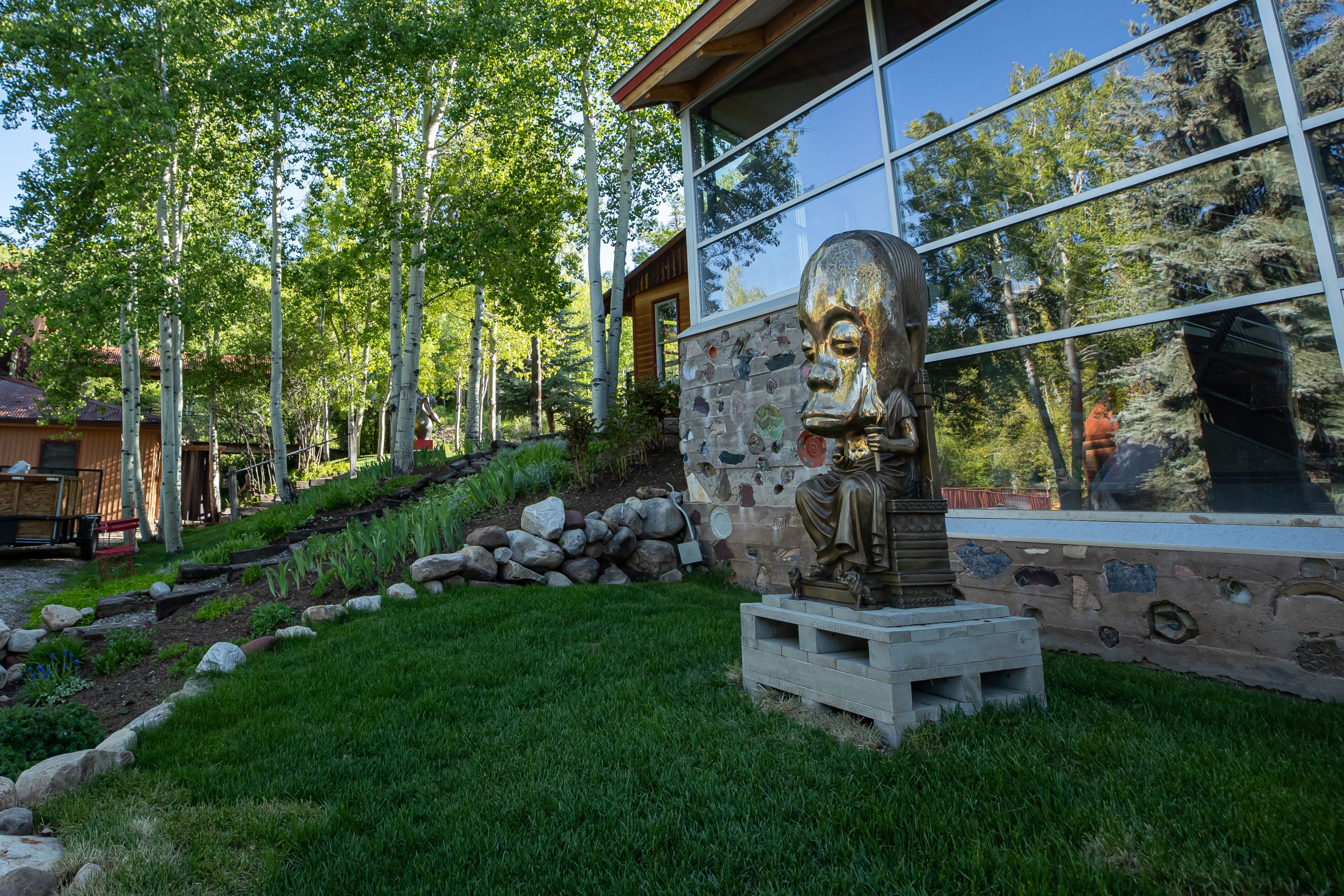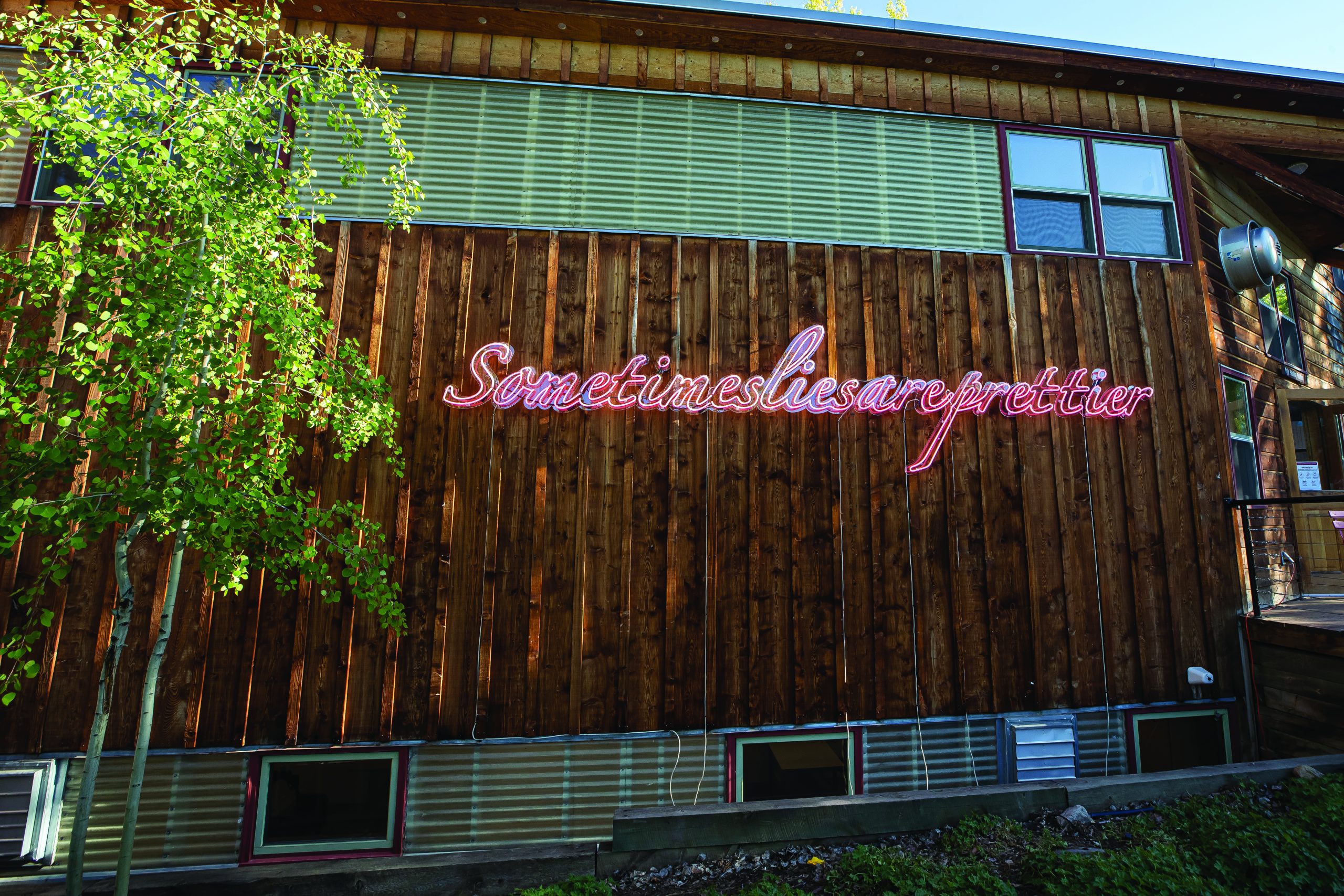
Outdoor Sculpture Exhibition
Anderson Ranch Arts Center is pleased to present our fourth annual outdoor sculpture exhibition. This iteration of the exhibition includes works by emerging and established artists, many with a personal connection to the Ranch, including past Summer Series speakers. Many of the works in this year’s exhibition are socially and politically engaged, encouraging discourse and conversation about race, history, identity and belonging.
If you are interested in purchasing a sculpture, please contact Andrea Jenkins Wallace, Vice President of Artistic Affairs, Artistic Director of Photography and New Media, at [email protected] or call 970-924-5044 for more information.
Read about the participating artists below and tour the campus.
Campus Hours:
Monday – Friday 8:30AM-5PM from June to September
Monday – Thursday 10AM -3PM from October to May

Digital Self-Guided Tour
To learn about the outdoor sculpture exhibition and campus buildings, view the digital self-guided tour.
Current Sculptures

1. Letha Wilson Double Arc Leaves and Lava (Hawaii California), 2020-2021| UV prints on corten steel
Courtesy of the artist and GRIMM, Amsterdam | London | New York
This sculpture will continue to change as the raw corten steel surfaces become weathered and further develop a rich patina. Wilson’s work pushes the limits of what a photograph can be, and challenges the traditional conventions of landscape photography. Her work asks us to consider our relationship to the environment, and the balance between the fabricated and natural landscape.

2. James Surls Three and Ten Flowers, 2014 | Bronze and stainless steel
Courtesy of the artist
The Three and Ten Flowers sculpture was made to look as though it grew up from where it stands. Its design is registered by a circular evolution giving rise to rhythmic numbers, vines with patterned stems that produce mathematical forms and shapes, but still maintain a sense of sensual blossom. Flowering vines are always something to behold — in the American south you see them on fence rows, on river banks and in thickets.

3. Woody De Othello thought in mind, 2023 | Bronze
Courtesy of the artist and Karma In partnership with Urban Art Projects
thought in mind (2023) is a freestanding bronze sculpture by Woody De Othello consisting of two oversized elements drawn from everyday life: a comb and the receiver of a rotary telephone. The effect of the larger-than-life scale (the work stands almost seven feet tall) of these prosaic, instantly recognizable objects is playful, but the sculpture nonetheless retains a sense of intimacy. The comb and the phone lean against each other, providing mutual support. Both objects are usually manipulated by hand, lifted to touch the holder’s face and head, and both are resolutely personal—the phone is a method of communication that connects one person directly to another, while the comb is an instrument used to style hair, a gesture that requires trust and care. In Othello’s words, “objects mimic actions that humans perform. They’re extensions of our own actions. We use phones to speak and to listen, clocks to tell time, vessels to hold things, and our bodies are indicators of all of those.”

4. Thaddeus Mosley Southwestern Suite, 2023 | Bronze
Courtesy of the artist and Karma In partnership with Urban Art Projects
Southwestern Suite captures the vitality and rhythm of Mosley’s chisel marks in its hewn surface. As one walks around the sculpture, its form changes dramatically, hidden openings reveal themselves, horizontals and verticals shift in priority, precarity and stability enter into conversation. The duality of heft and levity makes manifest the principle Mosley has termed “weight in space,” in which unwieldy materials are sculpted, and arranged so as to appear to levitate.

5. Enrique Martínez Celaya The Savior, 2008 | Bronze
Courtesy of the artist
The Savior is a bronze sculpture from 2008, depicting a deer pulling his homeland with its mountain and lakes. The homeland is attached to the deer’s antlers suggesting that it is both a source of guidance and growth and also as an attachment to who we used to be.

6. Sanford Biggers Oracle, 2021 | Bronze
Courtesy of the artist and Marianne Boesky Gallery, New York and Aspen
Oracle is a continuation of Sanford Biggers’ Chimera sculptures, a series of figurative sculptures created by combining African masks and European figures that explore historical depictions of the body and their subsequent myths, narratives, perceptions, and power. In 2021, a 25-foot version of Oracle was presented at Rockefeller Center in collaboration with Art Production Fund.

7. Tavares Strachan Sometimes Lies are Prettier, 2020 | Pink neon, steel, sintra
Courtesy of the artist and Marian Goodman Gallery, New York.
Sometimes Lies are Prettier speaks to the many ways we choose to accept the carefully constructed narratives that best fall in line with our lives. When we encounter this work, we are called to question the authenticity of our perspective. In addressing our personal discrepancies between fact and fiction, we can therefore acknowledge the tendency of historical narratives to obscure truths or exclude certain figures. We are ultimately forced to face the instability of our surroundings and our understanding of knowledge.

8. Richard Lapedes Time Flies, 2020 | Brass plate and steel fittings
Courtesy of the artist
Time Flies began with the idea of the metaphor, “time flies” and then the artist selected materials and methods to realize this idea visually. This piece was created using no welding or traditional fasteners and is built entirely of identical modular pieces. Time Flies became itself because the steel plates seem so animated as to be flying. And thanks to time’s passage, the constantly changing rust and green patterns give biological life to these wings.

9. Trey Hill The Night the Stars Were Dark, 2023 | Ceramic, steel and wood
Courtesy of the artist and Harvey Preston Gallery, Aspen
The central form in Trey Hill’s The Night the Stars Were Dark is an idealized tree, drawn from Greek and Roman classical sculpture. Historically, this tree was used to support fragile marble figurative sculptures and keep them from breaking at the ankles. This element of the larger sculpture often goes unnoticed, as the exceptional carving of the human form consumes the viewer. He finds this to be an effective analogy for the many subtle ways we find to support each other.

10. John Buck The Assemblage, 1991 | Bronze
Courtesy of the artist
John Buck’s artwork is informed by contemporary issues, as well as the primitive and folk art of many cultures. The figure represents the human condition from which abstract compositions emanate. The subject of each sculpture can be inspired by social, political, and personal concerns. The headless form of the figure, the assemblage on its shoulders, and around it, at times has specific parallel, and at other times a more casual reference.

11. Jason Mehl Anthropocene, 2012 | Bronze on granite base
Courtesy of the artist
This sculpture’s seemingly geological form contrasts sharply with sections that were deliberately cut and removed. The final composition represents our species immutable mark on earth’s geological record. This new epoch in human history is known as the Anthropocene… a point in time where the record of our impact has become irreversible. All materials used in the sculpting and casting of this piece were reclaimed from industries that have contributed massively to this impact.

12. Thomas, Hank Willis, Josephine and Kazumi (Real Red), 2018 | Rolled steel and enamel paint
Courtesy of the artist and Pace Gallery
This sculpture is based on the iconic shapes of cartoon speech bubbles. It function both as a sculpture and a bench that offer visitors a place to sit and interact with the surrounding environment and community. Akin to Thomas’s larger body of work, this sculpture explore the themes of location, family, belonging, and community. As Thomas has described, “When viewers occupy the piece, they are encouraged to contemplate what it means to inhabit their own speech and beliefs.”
Painted in a bright color to reflect the vibrancy of the surrounding environment, the bench both frame and enhance public space. It becomes a portal for participants to consider who community is and its values, where we come from, and where we are going. Participants become part of the piece by walking through the sign populated areas or sitting in the benches.
Inspired by Thomas’ original 2015 bench “Ernest and Ruth”– the title of which was drawn from the first names of his great-grandfather and grandmother respectively– the 2018 iterations are drawn from the first names of the extended family of Thomas’ close collaborators and studio members. In this gesture, Thomas points to a more liberal definition of family – one that includes the community around us and surpasses bloodlines.


